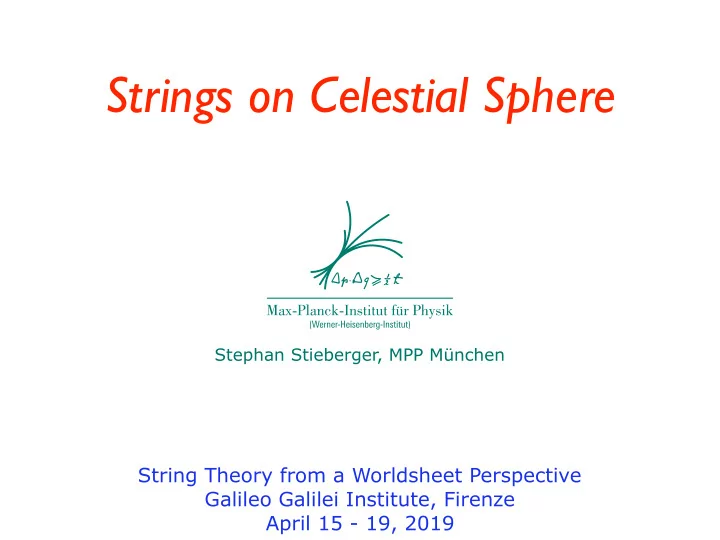

Strings on Celestial Sphere Stephan Stieberger, MPP München String Theory from a Worldsheet Perspective Galileo Galilei Institute, Firenze April 15 - 19, 2019
based on: St.St., T.R. Taylor: Strings on Celestial Sphere arXiv:1806.05688 Nucl. Phys. B935 (2018) 388-411 Symmetries of Celestial Amplitudes arXiv:1812.01080 to appear in Phys. Lett. B + work to appear
Recap: studying scattering amplitudes: deep connections between gravity and gauge interactions e.g.: KLT, BCJ, EYM (double-copy-construction) (in momentum or twistor space) traditional momentum space description: p μ k , k = 1,…, N p 2 k = − m 2 k • amplitudes specified by asymptotic wave functions, which transform simply under space-time translations • with manifest translation symmetry • traditional amplitudes describe transitions between momentum eigenstates D=4 Minkowski probably not the right space to see all symmetries of scattering amplitudes
Lorentz group in is identical R 1, D +1 to Euklidian D-dimensional conformal group SO(1,D+1) Scattering amplitudes in R 1, D +1 interpretation as Euklidian D-dimensional conformal correlators I + p in p out 1 2 I − p in 3 p out 1 D=2: celestial sphere p in 2 Can 2D CFT on celestial sphere offer some new insight into gauge-gravity connections ?
⃗ N particles on celestial sphere represent points on CS 2 p k ⟶ ( E k , z k , z k ) z k z k = p 1 k + ip 2 p k ) 2 = ( p 0 k E k = p 0 k ) 2 with: , k , ( p 0 k + p 3 k k = E k ( 1 , 1 + | z k | 2 ) , 1 − | z k | 2 1 + | z k | 2 , − i ( z k − z k ) z k + z k p μ 1 + | z k | 2 2 E k := ω k q μ ω k = (1 + | z k | 2 ) k E.g.: ⟨ ij ⟩ = 2 ( ω i ω j ) 1/2 ( z i − z j ) [ ij ] = 2 ( ω i ω j ) 1/2 ( z i − z j )
Lorentz symmetry: global conformal symmetry z i → az i + b on CS 2 cz i + d Amplitudes = conformal correlators of primary fields on CS 2 p 3 z k = p 1 k + ip 2 k z 3 x p 0 k + p 3 x k = z 1 g p 2 z 2 x p 1 D = 2 D = 4 g ∼ | z 1 − z 2 | h 1 + h 2 − h 3 | z 2 − z 3 | h 2 + h 3 − h 1 | z 1 − z 3 | h 1 + h 3 − h 2 D=4 space-time QFT correlators D=2 Euklidian CFT correlators D=2 CFT correlators involve conformal wave packets
<latexit sha1_base64="SfbQFaRH6PBiT9mJBmQ7+a/uSM4=">AAAHaHicdVRbTxtHFN64aUjdG7QPVdWXo3hLQSHI60RqpYoqlD4AgiSESyIYsMbjWXuU2UtmZl3syf6r/pn2tX3qr+iZ3R1DCF3b8jnfuX9zdga5FNp0u3/eaX109+N7C/c/aX/62edffLm49NWJzgrF+DHLZKZeD6jmUqT82Agj+etccZoMJH81eLPl7K8mXGmRpUdmmvPzhI5SEQtGDUL9pdY+GfCRSK2hg0JSVdp37B1+3adsk7HL23YFNCxDLmnK4Xc6Qa29DCxL40wlVEKuRELVtDLFRcpcbg2ENAmaNMTwS2MnnJlMQSy4HOpyOSRrAJt9S5KCcCnLlcuf89UNwnMtJDZoAQ3gLFCu5KsE+GVOJI8NcZYcBOR953F54RIoMRobUpK1ELDB8OTCkt+4NBSA5AmUVRXYdTVma2RAFcxWN1ZITpURVPZ34a3LhUVWHr29ltWV8Q2tXthHdc4yvBqw/diRYURaZIUjKsxdYAjL6FM5b0QPBZF4LEOK2b0kUrBkEMPLcjXEXNgHTbjB06oy9Da6awQI5L90Q0wEM+e/dXjRC6/q9mAoNFMYhLWeDEMY4yYwYaYQOs423NhR6DrqoVHnmCHcbdAbFUXKskSkI5jodcgKM8qcsgy3G65aIDwdzrenv9jprnerBz4UokboBM3zor90t0WGGSsSnhomqdZnUTc359YdCZMcV7DQPKfsDR3xMxRT7Fef22rxS/gekSHEbp2QfqjQ6xGWJlpPkwF6JtSM9U2bA2+znRUm/uncijQvDE9ZXSguJJgM3FuErCtcYzlFgTIlsFdgYySTOS7fq6LHRRzfGMQOkrLdJkMeExnbap3LWlXC1kvc6Bp1LUYJbfSYWRJjmUbdZNYShi/gZtkgQ20JrgS+qVNtplVdB2cTiz+u3Ik1kFEYqxIwysceNcjRHBlyU0MoeCzJhjWGgsdoA9E5MrNkxo1vO5l1ohro207kffZPPXqRXMcnfOIMeNmMJIdORFQlNdY9P/Oe93/ukef/PwnNEaEyH9MfytvIq6FDpPvwGt1mbPF3NQdeAtbfBD5m59RWL/FpWdb6Qa0f+Do7WzWw5R2e1fqzuYNvZMd7vLTNveDZTDxPfi8m9YB64l0OT/btFZneNjdaT/8NCw6IOxWVtjcn4dS3c+qdtj2y7ZE9YeenIOaRjAtcsFF1eE52R+f+/fLKLFOVsZGIqgR3a0Q374gPhZPeevR4vXfwpPP01+b+uB98FzwIVoIo+DF4GmwHL4LjgLX+aP3V+rv1z71/FxYXvln4tnZt3Wlivg7eexYe/AejA4fT</latexit> in momentum basis: plane waves with momentum p = ω q ( z ) in conformal basis: conformal primary wave functions Δ = h + h ∈ C construct complete set of on-shell wave functions in D=4: solves D=4 wave (Maxwell) equations and transforms as SL(2,Z) conformal primaries Pasterski, Shao arXiv:1705.01027 bases plane waves conformal primary wavefunctions V ∆ ± z ) = ( @ J q µ ) ( � q µ x µ ⌥ i ✏ ) − ∆ A µ ` ( x ; p ) = ✏ µ ` ( p ) exp { ⌥ ip µ x µ } vector fields µJ ( x ; z, ¯ p µ 3 continuous ∆ = 1 + i � ( � 2 R ) p 2 = 0 , z 2 CS 2 parameters p > 0 2 discrete 4 d helicity ` = ± 1 2 d spin J = ± 1 parameters incoming vs. outgoing incoming vs. outgoing in the massless case the change of basis is furnished by Mellin transform of plane wave (or plus a shadow transform): specified by x and ∞ ∂ J q μ ∫ conformal dimension V Δ ± d ω ω Δ− 1 e ± i ω q ⋅ x − ϵω μ J ( x μ ; z , ¯ z ) = Δ = 1 + i λ , λ ∈ R 2 0 ∂ J q μ no dependence on = ( ∓ i ) Δ Γ ( Δ ) D=4 momentum p μ ( − q μ x μ ∓ i ϵ ) Δ 2 ∂ z q μ = 2 ϵ μ + ( q ) = ( z ,1, − i , − z ) ∂ J q μ = Pasterski, Shao, Strominger, 2017 ∂ z q μ = 2 ϵ μ − ( q ) = ( z ,1, + i , − z )
N-point amplitude on celestial sphere ( p 1 + p 2 − p k ) ℳ ({ p i , ξ j }) N ({ p i , ξ j }) = i (2 π ) 4 δ (4) ∑ k =3 In the massless case, with or without spin, transition from momentum space to conformal primary wavefunctions with conformal dimension Δ j is implemented by Mellin transform: ϕ ( Δ ) = ∫ ∞ ˜ d ω ω Δ− 1 ϕ ( ω ) 0 Δ j = 1 + i λ j Mellin transform, with: z n ) = ( N ∞ N d ω n ) δ (4) ( ω 1 q 1 + ω 2 q 2 − n =1 ∫ ∏ ∑ ˜ ω i λ n { λ n } ( z n , ¯ ω k q k ) n 0 k =3 × ℳ ( ω n , z n , ¯ z n )
Recommend
More recommend